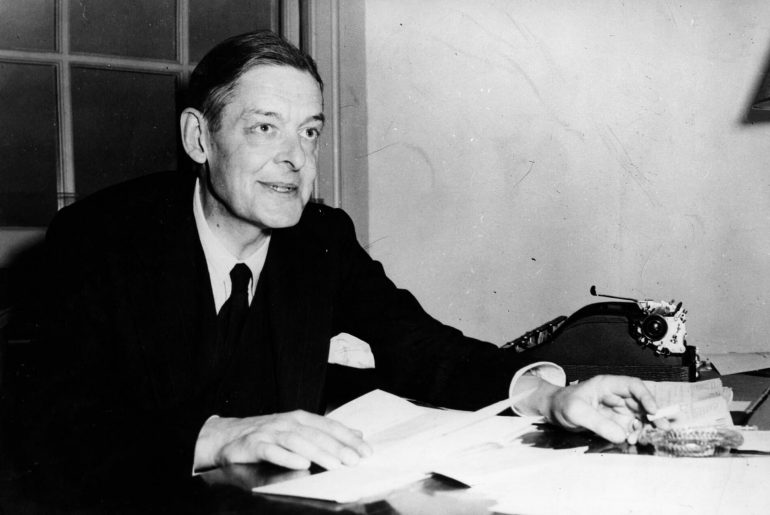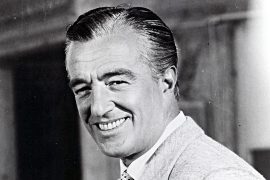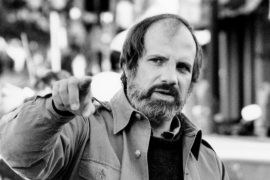THOMAS STEARNS ELIOT was one of the most important poets of the 20th century. He influenced Anglo-American literature not only through his poetry, but also through drama and astute essays. By enriching the poetry with free rhythms, abstract images, musical elements and innovative neologisms – based on classics such as SHAKESPEARE and VERGIL – he gave the English language new impetus.
The culmination of his poetry is the poem “The Waste Land” (1922), which was composed with the collaboration of EZRA POUND and established ELIOT’s fame. It depicts the world that got out of joint after the First World War. In 1948 T. S. ELIOT received the Nobel Prize in Literature.
Biography
THOMAS STEARNS ELIOT was born on September 26, 1888 in Saint Louis (Missouri). After a strictly puritanical upbringing, ELIOT studied at Harvard University and in Europe – including at the Sorbonne in Paris, in Munich and Oxford. About FRANCIS HERBERT BRADLEY (1846-1924), an English philosopher, ELIOT received his doctorate in 1911. BRADLEY was a representative of absolute idealism.
From 1914 ELIOT lived in London, where he initially worked as a bank clerk. At the same time he wrote reviews and poems. In 1927 he became a British citizen and converted to the Anglican Church in 1928. From 1922 to 1939 he published the literary magazine The Criterion, which he co-founded. From 1926 until the end of his life he was director of the publishing house Faber&Gwyer, which later became Faber & Faber Verlag. He accepted various visiting professorships in Cambridge and Harvard and received numerous honors for his work, including the 1948 Nobel Prize in Literature.
Literary creation
T. S. ELIOT was one of the most important poets of the 20th century. Above all through his poetry, but also through his dramas and his essays, he gave literature decisive linguistic and formal impulses.
Lyric
Contrary to the prevailing late-Romantic tradition, ELIOT drew on classical literature and English baroque poetry with its strict form in his poetry. He was also influenced by French Symbolism: this late 19th-century literary trend opposed the naturalistic depiction of the visible world and advocated pure verbal art. As a technique, all linguistic, tonal and rhythmic means were used. ELIOT’s first poems in “Prufrock and Other Observations” (1917) take up symbolistic stylistic devices: human despair in the face of a meaningless world is described in free rhythms and an ironically distanced tone.
The ELIOTS language is based on the modern conversational style; his metaphors come from the urban living environment. But there are also numerous allusions to mythical and cultural tradition. The high point of his poetry is the verse epic “The Waste Land” (1922, dt.: Das wuste Land), which was created with the participation of EZRA POUND and established ELIOT’s fame. It depicts the world that got out of joint after the First World War. The poem “Four Quartets” (1943) is another important work in which ELIOT propagates Christian humanism as a solution to the existential problems of modern man.
Drama
In his stage works, ELIOT renewed poetic drama. He wrote the verse drama Murder in the Cathedral (1935) for the Church. The Christian mystery play deals with the murder of the Archbishop of Canterbury THOMAS BECKET in the 12th century and addresses the importance of the church for social action. In his later successful social plays such as “The Family Reunion” (1939) and “The Cocktail Party” (1950) timeless human conflict situations are presented in the mold of modern society and Christianity as a balancing factor and reconciling element presented.
Essays
In his literary-critical essays, ELIOT deals in detail with the literary tradition in order to make it fruitful for the modern age. The essays formulate central poetic principles and show – like “The Idea of a Christian Society” (1939) and Notes “Towards the Definition of Culture” (1948) – ELIOTS ideas of a Christian society in the modern culture.
Works
lyric
Ash Wednesday (1930)
Old Possum’s Book of Practical Cats (1939)
Dramas
The Rock (1934)
The Confidential Clerk (1954)
The Elder Statesman (1959)
Essays
For Lancelot Andrewes (1928)
After Strange Gods (1934)
Essays Ancient and Modern (1936)
Poetry and Drama (1951)
On Poets and Poetry (1957)
What is TS Eliot most famous for?
Eliot was an American-English poet, playwright, literary critic, and editor. He is best known as a leader of the Modernist movement in poetry and as the author of such works as The Waste Land (1922) and Four Quartets (1943).
Why did TS Eliot won the Nobel Prize?
On November 4, 1948, T.S. Eliot wins the Nobel Prize in Literature, for his profound effect on the direction of modern poetry. Eliot was born in St. Louis, Missouri, to a long-established family.
What is TS Eliot’s style of writing?
He use stream-of- consciousness to show the chaos in of the modern man’s thinking. In addition, he uses many techniques such as imagism, repetition, fragmentation and other modernist techniques. All these techniques help depict the modern life for the reader and reflect its status in real manner.
What is the purpose of TS Eliots poetry?
In his poetry and criticism, Eliot provides a theory of the usefulness of poetry as a means by which to better understand oneself and others, thereby overcoming the isolation otherwise inherent in the human condition.
What are the themes of T.S. Eliot poetry?
By Theme.
Alienation.
Time.
Mortality.
Regeneration.
Tranquility.





